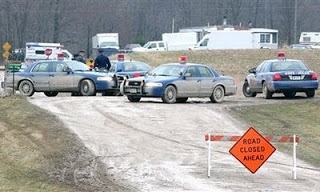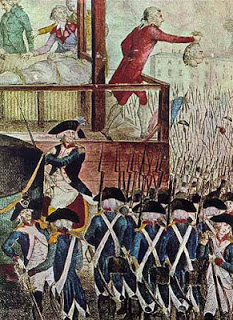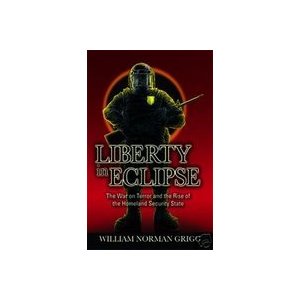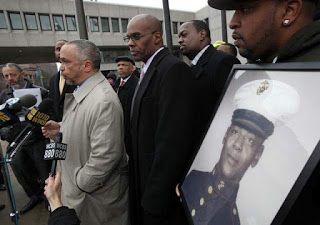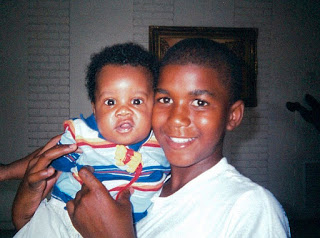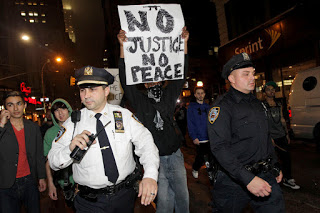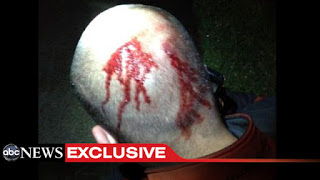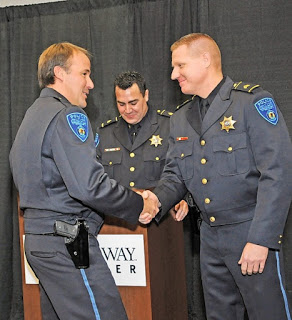 |
| Exonerated Hutaree defendants leave court: Future "seditionists" probably won't get a trial. |
Next time the Regime identifies a group of people as “domestic
terrorists,” the result might be summary execution, or imprisonment in military
custody, rather than a trial. This is one very plausible result of the
dismissal of “seditious conspiracy” charges against members of Michigan’s Hutaree
militia.
Thanks to the legal environment created by the NDAA, the
Feds won’t have to run the risk involved in submitting the next “domestic
terrorism” case to the scrutiny of a court. Now that Attorney
General Eric Hoder has helpfully clarified that “due process” and “judicial
process” aren’t the same thing, it’s entirely
possible that the next group of American dissidents identified by the SPLC or
other self-appointed political watchdog groups as “terrorists” could be targeted
by a drone-fired missile or a presidential strike team.
When asked by Rep. Thomas Graves (R-Georgia) if such "targeted assassinations" could be conducted domestically as well as overseas, FBI Commissar Robert Mueller pointedly refused to rule out the possibility. This was probably welcome news to Leslie Larsen, the FBI Agent who presided over the Hutaree case.
"We haven't worked a year
and a half on this investigation and risked [an undercover agent's] life to
walk away from this with 3 arrests," groused the secret police investigator two years ago. At
the time it appeared that the FBI wouldn’t be able to manufacture a criminal
conspiracy out of a few trivial firearms violations and a surfeit of
anti-government rhetoric.
During the past decade, false flag operations targeting disaffected Muslims have become the FBI’s métier. The Hutaree was the first non-Muslim “domestic extremist” groups to be cast as the lead in one of the Bureau’s
post-911 Homeland Security Theater productions. U.S. District Judge Victoria Roberts,
who was able to see the plot holes in the FBI’s implausible script, had the
character and good sense to dismiss the case with prejudice.
In her order granting the
defense motion for summary judgment, Roberts – who had previously expressed
severe skepticism regarding the supposed merits of the case – lambasted the Feds
for repeatedly venturing beyond "inference to pure speculation” and “attempting
to formulate an alternative theory of criminal liability” when it became clear
that they couldn’t provide tangible evidence of intent to commit an overt
criminal act. This resulted in a theory of the case “based primarily on two
conversations … the first on August 13, 2009, and the second on February 20,
2010.”
 |
| Hutaree Crackdown: SWAT operators raid a church in Michigan. |
The
Hutaree “militia” was a loosely organized group of obscure
people united by their entirely commendable hostility toward the criminal
clique calling itself the United States Government. They apparently shared a
set of apocalyptic beliefs about the imminent rise of the Antichrist, and they
engaged in survivalist training in anticipation of the End Times, when they
might confront the necessity to use defensive force against government agents –
whether foreign or domestic – in league with the enemy.
It
was in the context of this scenario that members of the Hutaree group supposedly
plotted to murder a law enforcement officer and then follow up with
opportunistic attacks on other LEOs who would attend the funeral. This
repellent terrorist tactic should be familiar to the Feds who investigated the Hutaree
group; after all, the government that employs them has made extensive use of
it. A
detailed report compiled by British and Pakistani journalists has
documented that CIA drone-fired missile strikes have killed “dozens of civilians who
had gone to help rescue victims or [who] were attending funerals” that
resulted from earlier missile attacks.
In
orchestrating its phony domestic terrorist plots, the Regime tends to use a
script inspired by its own acts of state terrorism abroad. The Hutaree “plot”
to assassinate a cop and then capitalize on the funeral may have been prompted
by the federal informant who infiltrated the group
and – acting as a provocateur– thoughtfully offered to teach them how to make improvised
explosive devices. It may have been stitched together in post-production by the FBI impresario presiding
over this little melodrama. What we know for certain is that it was
not conceived by the Hutaree activists, nor did they take ownership of it.
The
original indictment – which Judge Roberts eviscerated in a preliminary ruling –
accused the Michigan dissidents of making material preparations to carry out
specific criminal acts. When it was shown that there was no evidence to support
that charge, the Feds shifted their focus and charged them with “seditious
conspiracy,” which consisted of expressing opinions about government corruption
and making physical preparations to for self-defense against criminal violence
perpetrated by government authorities.
Citing
a Supreme Court precedent (Russell v. United States, 1962) holding that the
prosecution isn’t “free to roam at large – to shift its theory of criminality
so as to take advantage of each passing vicissitude of the trial,” Roberts
observed that the Feds were not free to “say that the alleged plan set forth
[in the original indictment] is irrelevant.” Yet that’s precisely what they
attempted to do.
Although
the supposed police assassination plot was central to the case against the Hutaree, “the
Government did not provide sufficient proof of the existence of a conspiracy at
all,” ruled Judge Roberts. “The Government says it is not certain whether the
Hutaree intended to initiate the conflict, or simply engage in it once it was
initiated by others.” While Hutaree members frequently engaged in what were described
as “diatribes” against law enforcement, “all of this speech is protected by the
First Amendment,” Roberts observed. Expressing hatred for the government’s
enforcement caste “is not the same as seditious conspiracy.”
Under
the Government’s theory of the case, Roberts noted, one could be charged with “sedition”
simply through his or her “mere presence at the scene” when a Hutaree activist spoke
about “going to war and killing police.”
One of the defendants, Tina Mae Stone,
was described by the Feds as an “active, engaged and vocal member” of the
purported conspiracy because she overheard two conversations – one regarding a
planned trip to Kentucky by David Stone, Sr. and the federal informant, and a second that took place in an FBI-rented warehouse in which the provocateur “discussed
explosives” with Mr. Stone.
The
latter conversation touched on the subject of using coffee cans and wine
bottles to make improvised explosively formed projectiles (EFPs). Ms. Stone joked that “she would take one for
the team and drink more wine, presumably so that the bottles could be used to
make explosives,” Roberts recounts. The Feds characterized that wisecrack as
evidence that she had “played an active, unhesitant, and continuing role in
obtaining materials to use in building EFPs” – despite the fact that she was
present for only one meeting with the Hutaree co-defendants, and never provided them
with anything.
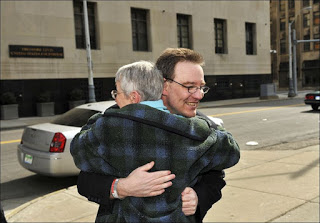 |
| Unchained: Michael Meeks hugs his aunt after being set free. |
Following
dismissal of the case, Hutaree defendant Michael Meeks, a 42-year-old former
Marine, said
that the salient lesson taught by the case was the need for Americans to “watch
what you say. Even the most innocent of statements can be used against you.”
Actually,
the lesson is that anything said in your presence can be
used against you -- and if a sufficiently incriminating remark isn't forthcoming from you or your friends, the Feds can always pay somebody to perform on cue, and on camera.
While the Feds didn’t succeed in imprisoning the Hutaree
defendants for life, they were able to steal more than two years of their
respective lives through pre-trial incarceration.
As a consolation prize, the
Feds were able to extort guilty pleas from David Stone, Sr. and his son Joshua on
weapons charges, which could result in prison terms.
Although
U.S. Attorney Barbara McQuade – the Madam DeFarge behind this case – wasn’t
able to feed the defendants to the guillotine, she expressed a measure of vindictive satisfaction that the felony convictions mean “that these defendants will never
be permitted to possess firearms again.” She also reiterated the Regime’s intent
to continue “dismantling” militias and other dissident groups suspected of
impermissible animosity toward their rulers.
Once again, thanks to the NDAA –
the Obama Regime’s “Law of Suspects” – the Feds will be able to use
extra-judicial means to “dismantle” dissident groups in the future.
The original Law of Suspects was enacted by France’s
revolutionary Jacobin government on September
17, 1793 (as it happened, the sixth birthday of the U.S. Constitution). The
decree permitted the wholesale imprisonment of several classes of people deemed
enemies of the State:
*Those considered “partisans of tyranny” or “enemies of liberty”
-- which in the Jacobin lexicon referred to defenders of the monarchy and
traditional institutions;
*Individuals who had been denied “certificates of patriotism”
issued by the revolutionary regime;
*Former “civil servants” who had been cashiered by the National
Convention;
*Former nobles and emigres and their families, if they failed to
provide suitable displays of “devotion to the Revolution”;
*Those who emigrated from France between July 1, 1789 and April 8,
1792.
As David A. Bell of Johns Hopkins University
points out in his study The First Total War: Napoleon's Europe and the Birth of
Warfare as We Know It, the Law of Suspects -- the template for every modern totalitarian legal system, including the NDAA -- was the enabling act
for the revolutionary Reign of Terror. As is the case with a contemporary American
deemed an “enemy combatant,” any French citizen branded a Suspect had no right
to appeal that designation. Protests of that kind were probably met with some
variation of the sentiment
recently expressed by Robespierre’s modern disciple, Sen. Lindsey Graham: “Shut
up – you don’t get a lawyer!”
The law dealing with "socially dangerous persons,"
notes the authoritative Black Book of Communism, dealt with "any
activity that, without directly aiming to overthrow or weaken the Soviet regime,
was in itself `an attack on the political or economic achievements of the
revolutionary proletariat.' The law thus not only punished intentional
transgressions but also proscribed
possible or unintentional acts” (emphasis added).
Additionally, the expression "socially dangerous persons" itself was based on "extremely elastic categories" that permitted the imprisonment of people in the gulag "even in the absence of guilt." This is because what the Soviet rulers were pleased to call "the law" specified that incarceration, exile, or execution could be employed as means of "social protection" against "anyone classified as a danger to society, either for a specific crime that has been committed or when, even if exonerated of a particular crime, the person is still reckoned to pose a threat to society." (Emphasis added.)
Soviet "law" discarded entirely with the idea of punishing overt acts, focusing instead on the supposed motivations of those deemed innately threatening to the regime. Note also that the Soviet system was rigged to nullify exculpatory verdicts. Soviet prosecutors, like Federal prosecutors today, considered themselves entitled to “shift the theory of criminality” as needed in order to justify detention of political offenders.
Additionally, the expression "socially dangerous persons" itself was based on "extremely elastic categories" that permitted the imprisonment of people in the gulag "even in the absence of guilt." This is because what the Soviet rulers were pleased to call "the law" specified that incarceration, exile, or execution could be employed as means of "social protection" against "anyone classified as a danger to society, either for a specific crime that has been committed or when, even if exonerated of a particular crime, the person is still reckoned to pose a threat to society." (Emphasis added.)
Soviet "law" discarded entirely with the idea of punishing overt acts, focusing instead on the supposed motivations of those deemed innately threatening to the regime. Note also that the Soviet system was rigged to nullify exculpatory verdicts. Soviet prosecutors, like Federal prosecutors today, considered themselves entitled to “shift the theory of criminality” as needed in order to justify detention of political offenders.
Detention of “socially dangerous persons” was the primary
function of the Soviet penal apparatus. As Paul Gregory points out in his book Lenin's Brain,
most of the prisoners consigned to the gulag were sent there not because of what they had
done, but because of what the state suspected they could do; they were being
isolated from the rest of society "because of actual or suspected opposition
to the Soviet state” – that is to say, that they had a “general plan” to “oppose
the authority” of the government,” as the U.S. “Justice” Department said
of the Hutaree defendants.
During the Senate’s discussion of the NDAA’s martial law
provisions, Sen. Graham warned that Americans suspected of terrorism – another “elastic” category that can include
practically any kind of organized dissent – should “know what will come your
way – death; detention; prosecution.”
Under the NDAA, the Regime has the luxury of ignoring
the third option listed by Graham when courts refuse to ratify every conspiracy
theory concocted by the Cheka (or, as it’s now know, the FBI). Or the Feds could simply avoid the messiness
associated with “judicial process” of any kind and implement the Obama
administration’s policy of executive assassination.
Thank
you so much!
I would like to offer earnest and emphatic thanks to
everyone who has responded so generously to my recent appeal. This really means
a great deal to me and my family. The first batch of personalized copies of
Liberty in Eclipse will be shipped out tomorrow (March 30). Two cases arrived a
couple of days ago, and I will continue to send out a copy of the book to
anyone who donates $20 or more to Pro Libertate. For non-Pay Pal donations, or
to send a mailing address, please contact me (WNGrigg [at] msn [dot] [com]).
Once again, thank you, and God bless.
Be sure to check out Republic magazine.
Dum spiro, pugno!

